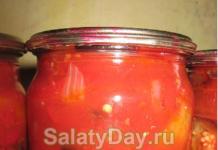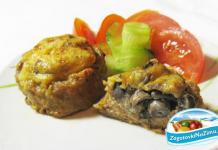Today for construction wooden houses very often profile beams are used: comb, “Finnish” and beams with several teeth. What kind of material is this, why is it good and how does it differ from laminated veneer lumber?
Let's try to understand everything in detail.
So, first of all, let's look at what the difference is between.
Firstly, the name speaks for itself. Glued laminated timber is made from boards (lamellas) pressed and glued together, while profiled timber is essentially a solid log.
Secondly, glued laminated timber goes on sale already dried, while profiled timber dries for about a year after the construction of the house is completed.
Thirdly, the thermal insulation qualities of laminated veneer lumber are somewhat worse than those of its profiled counterpart. This is because a glued product has a layer of glue between the lamellas and this layer, by the way, tends to dry out in some cases, which, of course, reduces the thermal insulation characteristics of the wall.

In general, at first glance it may seem that glued products are better than profiled ones, but such a hasty and unambiguous conclusion cannot be made. The type of timber that should be used is influenced by many factors specific to a particular project. This is the desired price of materials (profile wood is cheaper), and climatic conditions the territory on which the object is located and the purpose of the house.
Please also note that who made the material is of great importance.
In addition, the professionalism of the installers also plays an important role.
Perhaps they have a lot of experience in building houses from laminated veneer lumber, but they have never had to do anything from profile wood.
If in such a situation you build a house from profile beam, then most likely a lot of mistakes will be made, and, you see, “blaming” the material for this will be somewhat illogical.
So what kind of timber to use depends only on the nuances of your specific situation.
We will return to the review of profiled logs.
Material properties
First of all, it is worth highlighting the fact that this material has a slightly different structure, the way it is connected to each other, and this to some extent affects its properties.
In particular, we are talking about the fact that timber profiles are different.
For example, a beam with “comb” type grooves is a log, at the bottom and upper plane which contains many “teeth”. This is both bad and good at the same time.

Good - because no additional insulating tape is required between the logs, since due to the large number of teeth in the grooves, the possibility of cold air passing into the room is simply eliminated.
But the bad thing is that such material is much harder to attach to each other. This is because after the logs are delivered to the site, they inevitably fall into conditions of changes in humidity and temperature, and accordingly lose their original shape.
That is, simply put, they become deformed and after that their teeth are very difficult to insert into the grooves of neighboring logs without using a sledgehammer. And using a sledgehammer can lead to cracks in the timber, which, of course, will reduce its thermal insulation qualities.
But if you do make a “comb”, it will turn out to be very durable and warm home or .
The second type of timber is the so-called “Finnish” profile. We can say that for construction this is the simplest and quick option. Because there are only two spikes here - at the edges, and accordingly, joining such logs is a very fast process. In addition, walls made of this profile practically do not shrink.
However, there are, of course, a couple of negative points:
- In order to connect such logs really tightly, you need not only to try very hard, but also to really understand this matter and be able to work with this particular material.
- A house made of this type of profile timber will not have good thermal insulation qualities unless a special inter-crown is placed between the logs.
It turns out that from the “Finnish” profile residential buildings it is quite possible to build, but it is very important not to forget about additional insulation.

The third profile option, which is often used when building houses from profile timber, is a “three or four tooth” beam. In fact, this is the most universal look profile, since its spikes are wide enough not to deform during storage on site. That is, the material can be safely stored - it will be quite easy to install.
As for thermal insulation characteristics, then, as a rule, for a not very harsh climate, a few Finnish profile spikes are enough to block the path of frost and wind. But if you live in northern regions, then, perhaps, it is better to use a “comb” beam.

As you can see, it is impossible to 100% correctly determine which timber profile is better - everything again depends on the nuances of the situation. It turns out that each type of material is good in its own way, but also has its drawbacks.
Advice: if you are planning to build a house with your own hands, but are not sure which type of material is best to choose, then at least play it safe and consult a professional about this.
It will not cost much, but the risk of making a wrong choice will be minimized.
Well, we’ve sorted out the types of timber, now let’s get down to it general overview properties of the material.
Advantages
So, we can highlight the following advantages of this material and houses made from it:
- This is 100% solid wood, the basis of which is such species as spruce, pine, Siberian larch or cedar. Wood processing is almost always performed using high-precision imported equipment.
Thanks to this factor, the tenons fit very tightly into the grooves of adjacent logs, which, of course, gives the walls of the house high strength and eliminates the need to purchase numerous fasteners;

- The structure of the profile beam does not contain any glue. This means that the strength of the product does not lose over time, and there will be no chemical fumes;
Please note that the absence adhesive compositions It also affects the internal microclimate in the room – in a positive way.
Such houses made of profiled timber, or rather their walls, “breathe” very well, so to speak 100%, and all because their structure is completely natural and there are no artificial layers.
So if you want your house to be not only warm in winter, but also cool in summer, then a house made of profiled timber is really what you need.
If everything is done correctly, then on a hot day you won’t need any air conditioning!
- Thanks to walls made of profile logs, heating costs are significantly reduced in winter period, it does not require any additional measures on insulation – curtain facades, “wet” and so on;
- No standard exterior or interior finishing required interior walls . That is, the house will not need to be plastered, puttied, painted, wallpapered, etc. For what? After all, logs already have a magnificent appearance, agree;
- There is no need to treat the timber with antiseptics, because this procedure is performed at the factory. Moreover, the effect from this is greater than from applying an antiseptic with your own hands, since the processing process at the factory takes place in an autoclave.
This allows you to capture the maximum structure of the tree, and thanks to this it does not deteriorate for a very, very long time;

- Relatively simple instructions assembling walls from profile timber. In fact, all that is required is to drive the tenons of each subsequent log into the grooves of the previous one as correctly and accurately as possible.
As you can see, it turns out that this type timber is a truly excellent material for building a house. Environmentally friendly indeed natural material, which is also easy to assemble and durable. And the price is relatively low, what else do you need?
You can use a calculator to calculate the amount of timber for construction:
Wall length
m
Wall width
m
Wall height
m
Beam section
150x150 mm. 180x180 mm. 200x200 mm.
Beam length
5 m. 6 m. 7 m. 8 m. 9 m. 10 m. 11 m. 12 m.
However, profile logs, of course, also have disadvantages. And they definitely need to be mentioned.
Disadvantages of the material
In fact, there are only two shortcomings.
- A house made from profile timber must stand for 10-12 months, and only then can you begin to decorate it. That is, put interior doors For example, it is not recommended to putty ceilings immediately after construction is completed. The shrinkage is small, but it is there. However, what material is a house made of not subject to shrinkage? Therefore, it is very difficult to determine whether this point should be considered a disadvantage.
- As the logs dry out, cracks may appear on them. As a rule, they are small, but they have to be sealed later.

In principle, it can also be noted that almost all projects of houses made of profile timber do not provide for the design of buildings in the high-tech, modern, etc. styles. And this is understandable - after all, wood is wood, and such walls are only suitable for houses that claim to be environmentally friendly and natural.
So if you want to make a house in which stone or metal elements will predominate, then a profile log is clearly not the material you need.

All photos from the article
It's unlikely that anyone will refuse a little country house from timber. This great option in order to have a great weekend with your family and relax from the bustle of the city. If desired, you can build a full-fledged residential building from this material, it all depends on finances. Profiled timber is convenient because, due to the geometry of the surfaces, it provides excellent rigidity to the walls and is extremely convenient during construction.

Features and types of profiled timber
The main difference between regular and profiled timber is the surface geometry. If it is smooth, then the profiled one has grooves and tenons cut into it. During construction, the grooves fit into the tenons, and the likelihood of the timber shifting is reduced to zero.
At the same time, the price of such lumber is not much higher than the cost ordinary timber, so if there is a choice, then the profiled option is best. Classification can be performed according to several parameters.
Depending on the shape of the front surface, we can distinguish:
- timber with a smooth front surface;
- with a semicircular outline of the front surface.

Pay attention!
In terms of durability, there is not much difference between these options, so you will have to choose based only on aesthetic considerations.
Also, profiled timber can be either solid or glued. One-piece is easier to produce, but large section it is more difficult to dry it to the required conditions, in addition, after construction, when the house shrinks, wide longitudinal cracks may appear in them, and the settlement of the house is quite large.
Glulam beams are made by gluing together several long boards and only then comes the profiling stage. The boards are pre-dried so the timber does not need to be dried after gluing.
When processing the surface, you can give any profile; in construction, the following options are used:
- German profile– different a large number tongues and grooves, a kind of comb is obtained. This design creates a reliable barrier to cold and moisture;
- the Finnish timber profile is distinguished by the presence of only 2 large ridges along the edges of the timber;
- There are also intermediate options with the presence of 3 or more ridges and grooves for them.
Home Building Basics
At first glance, building a house involves laying the logs correctly (so that the tenons fit into the grooves). But in reality, you have to take into account a lot of subtleties on which the durability and reliability of the building depends.
Which profile is better for a home?
Usually you have to choose between a comb ( German profile) and classical Finnish or its derivatives (with a large number ridges).
In order to determine which option is better, you need to understand the mechanism of operation of the assembled structure:
- The German profile was developed in order to eliminate the laying of heat insulation between the logs. Such reasoning was based on the fact that in production the geometry of the teeth and grooves would be ideally observed, but in reality this is quite difficult to achieve, and during storage the teeth may be damaged or swell due to moisture;
Finnish houses made of profiled timber traditionally provide their owners with the maximum level of comfort and a lot of advantages even at the construction stage. Architectural excellence and thoughtful design are reflected in every wall. Live in it for at least a month and you simply won’t be able to find any reason to move into a dull apartment.
Advantages Finnish houses made of timber from the company "Dachny Season"
- Our team of builders will complete the building assembly in just 2 months.
- The material is 100% environmentally friendly and safe. He literally breathes, letting you into every room fresh air and positive emotions.
- A large number of windows provides excellent natural light. Even the smallest rooms will provide residents with comfort and coziness.
- We treat the timber with a special protective impregnation, which ensures complete invulnerability to attacks by harmful insects and improves the fire resistance of housing.
- The price of modern wooden houses remains extremely low. At the same time, you can partially verify their level of quality from the photos on our website and be fully convinced already in the first days of your stay.
Thanks to its environmental friendliness, excellent technical characteristics and beauty, wood is rightfully considered one of the best building materials. Thanks to unique properties natural wood in wooden house always a charming and unique microclimate. Finnish timber is popular among private developers due to its excellent technical characteristics and guaranteed quality.
How does Finnish-made laminated veneer lumber differ from its domestic counterparts? When starting to build a house or country cottage, it is extremely important to choose the right material. Let's consider the production technology and structural features of Finnish timber so that you can make an informed and informed choice.
Production technology and profiling

Since the construction of houses made of wood has been relevant and in demand for many centuries, manufacturers are constantly trying to improve and modernize not only production technology, but also the configuration of wooden slats. The main goal is to eliminate as much as possible the shortcomings of wood, of which, by the way, there are not so many.
Glued laminated timber production technology

One of the significant disadvantages of conventional logs is the instability of the geometry. The material expands when exposed to moisture and cracks and warps when sharp changes temperature regime.
Improved technologies for the production of laminated wood structures, which were developed relatively recently, almost completely eliminate the disadvantages of wooden slats.
Profiled timber Finnish profile is produced under strict observance of the following conditions:
- The logs are sawn into lamellas of equal thickness, which relieves the internal stress of the material and guarantees the stability of the lamella geometry. The timber does not deform or crack under the influence of adverse weather conditions;
- The low humidity of the material (no more than twelve percent) guarantees minimal shrinkage of the walls over time. Finnish manufacturers carefully control the drying process. And since process fully automated, the quality of the material and a certain moisture content of the lamellas are guaranteed;

- After calibrating the boards and eliminating wood defects, the lamellas are spliced and sanded. This treatment allows you to achieve the ideal geometry of the beams;
- The gluing of the lamellas is carried out under pressure. As an adhesive composition, manufacturers from Finland use only environmentally friendly materials that do not affect the main technical specifications wood. Finnish-made laminated veneer lumber has the ability to “breathe”, which creates a unique comfortable microclimate in the room.

Important. The strength and durability of the material is also given by the direction of the fibers of the glued lamellas.
The cut fibers of two adjacent lamellas are arranged in annual rings in opposite directions.
This arrangement of annual rings reduces internal stress, which significantly increases the strength of the material.
- Since the bars are high accuracy are profiled and trimmed, then assembly is easy to do with your own hands. The tenon-groove system allows you to connect structural elements without gaps and distortions;
- Each part is marked and packaged according to specifications, as required by the instructions, so the construction of a house from this material can be carried out in the shortest possible time.
Projects made from Finnish laminated timber are deservedly popular among private developers. A cottage made of wood is not only spectacular and beautiful building, but also a comfortable, durable and environmentally friendly building.
Profile - why it is convenient and reliable

Profiled timber is distinguished by the presence lock connection lamels, so the crowns of the beams are tightly and securely fastened.
There are two common types of profile:
- German profile – equipped with multi-ridge (tongue-and-groove) connections;
- Finnish timber profile - distinguished by crown cups connecting the lamellas.
Important. Each manufacturer always has its own know-how to improve profile connections.
But at the same time, the essence of the profiled connection remains unchanged - the interlocking longitudinal connection eliminates lateral movement of the material and eliminates cracks and gaps during assembly.
Main features of timber from Finland

Finnish timber is one of the elite building materials, as its cost is quite high. But build small sauna or a sauna made of Finnish wood can be afforded by almost everyone.
What is different about timber from Finland?
- The arcs of the annual rings of the boards being glued together are directed towards the center, and the core is directed outwards. This arrangement of wood fibers guarantees increased strength and durability by reducing internal stress in the timber; (See also article.)

- Various breeds coniferous trees do not mix, which guarantees a beautiful and uniform tone;
- The strength of the gluing is ensured by vertical splicing every four to six meters, but not more than three meters. As can be seen in the photo, this gluing technology guarantees a magnificent appearance and an almost invisible seam;
- By Finnish technology Only wide slats are used. This is due to the fact that adhesive base saturates the wood by one and a half to two centimeters. Therefore, thin lamellas are almost completely saturated with glue and lose their ability to “breathe”. Finnish timber with a thickness of 200 millimeters is made from three spliced lamellas with adhesive impregnation of no more than eight millimeters. This allows you to completely preserve all the positive technical characteristics of natural wood.
It is worth noting that a high-quality imitation of Finnish timber in terms of technical and aesthetic characteristics is almost identical to its analogue, but the cost of such material is much lower.

Advice. By purchasing building material made of wood, give preference to timber from winter wood.
It is drier and more durable.
A distinctive feature of winter wood is the lighter color of the ends and the absence of fiber on the longitudinal cuts.
Experts advise checking the material in the following way.
Drop iodine onto the cut of the timber - if the stain turns blue, it means there is a lot of starch in the tree, and this distinctive feature"winter" lumber.
Advantages and disadvantages of laminated timber

Since the price of this building material is quite high, we will dwell on its main advantages and disadvantages. Are the advertising characteristics so fair and is it worth overpaying for foreign guaranteed quality? After all, offers from domestic producers great multitude.
The “advantages” include the following characteristics:
- High resistance to deformation due to the absence of internal stress. The building will retain its shape and size and will not deform over time;
- Optimal humidity prevents long-term shrinkage of the building.

Advice. But laminated veneer lumber is wood, so minimal shrinkage of the house still occurs over time.
Therefore to the internal finishing works It is better to start a few months after the construction of the house.
- Wood guarantees excellent thermal insulation;
- Treating the lamellas with antiseptic and fire-retardant impregnations before gluing guarantees the strength and durability of the building;
- Short deadlines for work. a construction set that you can even assemble with your own hands. Marking of all parts and detailed instructions allows you to build a cottage in a month (not taking into account the construction of the foundation).

Profiled timber This is a modern building material that is made from coniferous trees by milling and planing. At the same time, a special profile is attached, such material is easy to lay, thanks to the tenons and grooves, the walls are assembled from it like a constructor, which significantly saves time and money, the walls remain geometrically smooth, thanks to the rigid coupling, in the form of a lock and do not require further finishing.
Types of profiles and sizes
Exists three main sizes profiled timber: (dimensions are indicated in clean form)
- 140 per 90 mm (wall thickness 9 cm) - For country houses and mainly goes like a partition beam
- 140 per 140 mm (wall thickness 14 cm) the most popular timber size, the so-called “golden mean”
- 140 per 190 mm (wall thickness 19 cm) used for cottages and houses for permanent residence

By profile type:
- Finnish- the beam profile has two pronounced spikes
- Comb- has large number thorns
- Scandinavian- this is a subspecies with a comb profile.
- Lunar- or in other words, a “block house”, semicircular on the outside and smooth on the inside, the most popular look timber
- Smooth- the profile is smooth on both sides, with beveled chamfers.
By degree of humidity:
- timber natural humidity (25-40%)
- Chamber drying timber (forced) (no more than 20%)
By harvesting season:
- Winter forest(raw materials for timber, prepared in winter)
- Summer forest
Production technology
For the production of profiled timber they use conifers wood, spruce or pine. We take blanks of unplaned timber measuring 150 by 100, 150 by 150 or 150 by 200 mm, depending on the size we want to obtain. Using the milling method, 0.5 cm is removed from both sides, while the beam is given a profile (a semicircle on one side or even sides, two tenons or a comb), in the other two a profile is formed in the form of a “tenon and groove” At the output we get a planed timber profiled on 4 sides, the whole process takes 1-2 minutes per 1 piece. (beam 6.0 meters long). Profiling is carried out on special four-sided planing machines profile cutters.
The photo shows standard blanks of unplaned timber, ready for milling and profiling

Timber after profiling in stacks, ready for shipment to the sawmill

Close-up, beam profile from the outside under the “block house” (lunar)

The profile of the timber is smooth on both sides with natural moisture under the canopy before shipment

Important: Finish walls made of such timber must be sawed down and cut into a root tenon (another name for a “warm corner”) or its variety, dovetail. Between the crowns they always lay interventional insulation jute.
Cutting the corners of houses, only in the root tenon, according to GOST 30974−2002

Jute insulation between each crown of timber of main walls and partitions

Thanks to the tenons and grooves, the timber is connected into a rigid geometrically even structure

For reference:
In one cube of timber 150 by 100 mm - 11 pcs.
In one cube of timber 150 by 150 mm - 7.0 pcs.
In one cube of timber 150 by 200 mm - 5.5 pcs.

This affects the cost of a log house; for example, a house of equal size and area made of 150 by 200 mm timber will always be more expensive. Since the number of beams in a cube is smaller, which means more cubes are needed for construction, take this into account when requesting or planning the construction of a future home
The choice of timber profile does not affect the cost (you can choose either a lunar profile (under the “block house” from the outside) or even on both sides).
- We have own production profiled timber.
- There are two in production drying chambers, at your service, chamber drying timber.
- And also timber for winter harvesting.


















